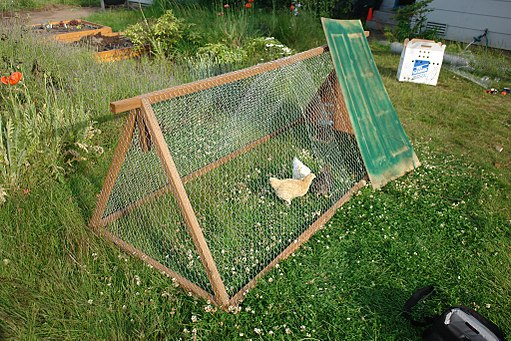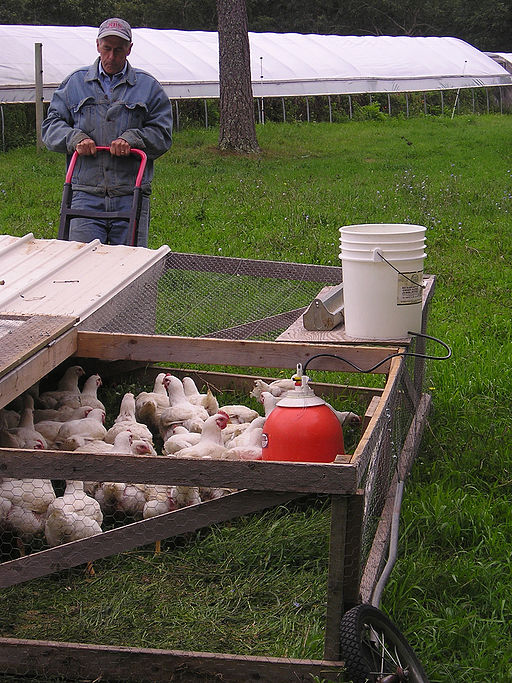A chicken coop tractor is an excellent way to keep chickens, because it meets their needs to roam and forage naturally, while still protecting them from predators and from escape.
Also called a chicken ark, the chicken coop tractor is a portable chicken enclosure without a floor. It is lightweight, and often has wheels to make it easier to move from place to place. Within the enclosure, chickens roam freely, eating grass, weeds, and insects beneath their feet. As they naturally forage, they scratch at the soil with their sharp claws, turning over the soil and aerating the ground. Chicken droppings are mixed in with the soil, providing nutrients for growing plants.
Benefits of a chicken tractor
A chicken tractor has many benefits, both for the chickens and for their owners. With a chicken tractor, along with a fixed chicken coop:
- Chickens live in accordance with their natural need for exercise and time outdoors
- Chickens are exposed to new experiences and new food sources, rather than having a fixed environment and fixed diet every day
- The ability to forage provides the chicken’s diet with more variety, more trace minerals and micronutrients, and reduces the owner’s cost of purchasing food
- Chickens eat harmful insects and unwanted weeds, promoting a healthy garden without reliance on pesticides or herbicides
- Chickens turn over and aerate the soil by scratching at it, promoting the health of the soil
Chicken droppings are deposited on the soil, where the nitrogen and phosphorous-rich manure can nourish new plants. This also reduces the need for the owner to manually clean up chicken droppings, improving cleanliness and hygiene, and reduces the risk of disease or illness from harmful gasses emitted by droppings accumulating in an enclosed area.
A generous and well-kept chicken tractor can have a smaller indoor area per chicken than a stationary coop. The chickens’ need for space, exercise, and a rich environment are met during the day when they are outside.
Chicken tractors also offer benefits as opposed to simply allowing chickens to free range:
- Chickens remain protected from predators
- They have protection from bad weather
- Chickens are not free to wander off
- Hens lay eggs in the provided nest boxes rather than hiding them in foliage, making them easy to find
- The benefits of the chickens foraging, weeding, and aerating the soil can be directed toward a specific, desired area within a field, lawn, or garden. In other words, controlled grazing.
What is a chicken coop tractor made of?
There are hundreds of different designs for chicken tractors, of every size and shape, but they all consist of the same basic components:
- An enclosed, weatherproof nesting and shelter area
- An attached, outdoor chicken run, covered with wire mesh to allow fresh air and sunshine while excluding predators
At minimum, the nesting area should have:
- An elevated nest box for every 3-4 laying hens in the flock
- A door or access hatch for the owner to harvest eggs and clean the enclosure, but that can be closed and latched to prevent predators
- A door or access hatch that allows chickens to move freely inside and outside, but that can be closed and latched to prevent predators
- An elevated roost for chickens to sleep on

By Josh Larios from Seattle, US (DSC03369) [CC BY-SA 2.0 (https://creativecommons.org/licenses/by-sa/2.0)], via Wikimedia Commons - A watering device
- A feeder is optional inside the nesting area, but a good idea
The nesting area should be:
- At least 2 square feet of floor space per bird
- A minimum of 8 inches of roosting bar per bird
- At least 1 square foot of nesting area for every 3-4 hens
- Have a solid roof and walls to provide protection from weather and predators
- Have mesh-covered openings for ventilation and fresh air
The attached chicken run should be:
- At least 4 square feet of floor space per bird
- Enclosed on all sides and over the top with wire mesh, to prevent predators, including predatory birds, from harming the chickens
A chicken coop tractor can generally be made of:
Wood
Keep in mind that the goal of a chicken tractor is to keep it lightweight and portable. The frame of the tractor and many structural components are often made with wood. You can also also use tin roofing panels for the roof and as cladding for the sides, due to the light weight and weather resistance. PVC pipe is also frequently used as framing material because it is water-resistant and lightweight.
Wire mesh
Despite the name, “chicken wire” is not the best material to use in your chicken tractor. Chicken wire will contain chickens, but is too lightweight to exclude all predators, the openings are too large to exclude small rodents and pests, and it rusts easily in the weather. The best mesh to use is 1/2” galvanized hardware cloth, which will contain the chickens safely and is robust enough to exclude pests and predators. Use wire mesh to enclose the run and to cover the ventilation windows in the nesting area.
Hardware
Latches, screws, brackets, etc. depending on the size and complexity of the design.
How to maintain a chicken cop tractor
Move it frequently

Clean the nesting area daily
You should clean the nesting area every day, and many owners do this routinely when they harvest eggs.
Cleaning the feeders and replacing food and water twice a day is also important. Chickens wake up before dawn and they wake up hungry. Food and water should be given first thing in the morning and again in the evenings. This is generally done when opening the hatch to give chickens daytime access to the run, and then in the evening when securing them for the night.
Conclusion
Following these tips will help you make a great chicken tractor, and experience all the natural benefits of having healthy, happy chickens.

